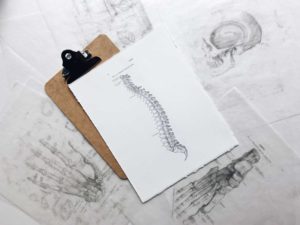Poor posture affects up to 90 per cent of people according to the Chiropractor’s Association of Australia (CAA). In severe cases, long term bad posture can lead to scoliosis, a condition that results in the spine twisting from left to right, instead of running in a straight line from top to bottom. Depending on the severity, scoliosis of the spine can have a detrimental impact on vital organs, such as your heart, liver and kidneys.
The Which Posture Are You? website is an initiative of the CAA and features information and tools to help people assess their postural health and find out how to improve posture and well being. Four main postural types are identified.
Weekend Outdoors
There are steps you can take to avoid injury from maintaining improper posture whilst gardening.
Bending over weeding and watering, the hours can quickly slip by. Then there are activities like digging, carrying buckets, pushing wheelbarrows and lifting. Done the wrong way, these activities can place strain on your back, particularly when your body is held in unsound positions over a sustained period of time to perform them. It’s easy to understand how back pain can arise from pursuits in the garden if you don’t undertake these activities in the right way.
DIY activities around the home can result in a high rate of injury. In Australia it’s been shown that of DIY injuries presented at an emergency department, 75 per cent of incidents occur in a residential setting, particularly the garden.
Common posture problems include Dowager’s Hump (increased kyphosis) a bent over posture more common in older people, especially women, round shoulders and uneven or rotated hips, caused by twisting to shift dirt from a wheelbarrow to a garden, or to pull out and pile up weeds.
Give your posture a sporting chance. Before you enter the garden and having a few simple rules in mind, you can minimise your chance of experiencing some of these common gardening afflictions.
Aside from using the correct posture and tools, take frequent breaks and walk around and stretch, as staying in the same position for too long can contribute to a sore back later that night or the next morning.
The Office Routine
Our backs are not designed to spend long periods of time sitting at desks, a common feature of many work environments.
Spending six to eight hours a day in front of a computer can lead to shoulder, arm, hand and neck problems, as well as issues with balance and coordination.
One study revealed over 45 per cent of office workers experience neck pain. Back problems are big contributors to lost productivity in the workplace.
Lower back pain is one of the most common causes of disability among people of working age and its impact on industry is enormous. After headaches and colds, back pain is the third most common reason for taking time off work.
Specifically, the work-related physical activities related to the onset of low back symptoms include lifting heavy weights, bending and twisting and working in the same position for extended periods.
Common posture problems amongst office workers (particularly computer operators) include forward head posture, round shoulders distinguished by the hunched over appearance it creates and rotated hips, which can be caused by holding a poor position for a long period of time, such as sitting at your desk twisting to write as well as looking at the computer.
The good news is postural issues can be corrected, and even, in some instances reversed.
When in a working environment that requires a lot of desk and computer work, make sure your workstation equipment is ergonomically sound (see ergonomic tips below).
Take regular breaks. You should take a one-to-two minute break every 30 minutes you spend sitting at a desk or workstation.
Ergonomic tips
- Adjust your chair so your feet are flat on the floor, your thighs are parallel to the ground, with your knees forming a 90 degree angle.
- Your eyes should be in line with the top of your monitor.
- The keyboard should be level with the height of your elbows when your arms are hanging loose by your side.
Weighing down kids
In addition to the possibility of injury in the playground and on the sports oval, the seemingly innocuous trip to and from school also presents its own postural challenges to children.
According to an international study, daily backpack carrying is a frequent cause of discomfort for school children. School backpacks are heavy for 79 per cent of children, causing fatigue to 66 per cent and back pain to 46 per cent.
Although fashionable, many of the current bags children are using for school don’t allow for even weight distribution across the back. What’s more, many children put extra pressure on their spine by carrying their bags below their waistline/lower back.
There have been links established between thoracic (middle back) pain in adolescents from postural changes associated with backpack use and participation in certain sports. Furthermore, the thoracic (mid) to lumbar (lower) regions of the spine can experience deteriorating posture as a person becomes fatigued from carrying loads, such as backpacks. It can take less than 20 minutes of carrying a load for this fatigue to start.
These problems are all the more concerning when you consider spinal issues during adolescence can impact on the correct development of your child’s spine as they grow into an adult.
Children are more likely to experience forward head posture while wearing a loaded backpack. Other posture problems include slouching and uneven hips.
It is not uncommon to see children carrying school backpacks on one shoulder – this uneven weight distribution can cause a postural compensation and result in uneven hips.
Backpack tips
- Backpacks should be no heavier than 10 per cent of a student’s weight when packed.
- Backpacks should be no wider than the student’s chest.
- Choose a backpack with broad, padded shoulder straps and waist strap.
- Don’t wear the backpack lower than the hollow of the lower back.
- Place any heavy items at the base of the pack, close to the spine, for a better distribution of the weight.
Mum’s Balancing Priorities
There’s no doubt pregnant mums and mums with young babies carry a heavy burden – literally.
As they tend to their daily activities, posture is often the last thing on their minds. Unfortunately, this can often lead to every day tasks – such as housework and social interaction – being performed in ways that are physically taxing to their health and posture.
While postural issues don’t always manifest themselves in a manner that allow us to easily recognise we have them, back pain can be a clear sign you may need to have your posture assessed.
Approximately 70 per cent of women will, at some time in their lives, report low back pain. During pregnancy, while 50 to 80 per cent of women have reported back pain, one-third of pregnant women claim this low back pain is a significant problem.
Activities such as twisting to lift children out of cars and frequent carrying of babies or young children on the hips can cause hips and shoulders to become uneven.
As a woman’s body adapts to her changing weight and shape during pregnancy, the spine and pelvis realign to serve as a counter-balance. One of the issues that can arise from this is forward head posture. Dowager’s Hump (or increased kyphosis) is another postural issue that can occur during pregnancy. It is a condition that increases the natural curve of the upper back. The increased weight from carrying a child can pull your pelvis forward, increasing the curve to your lower back (or increased lordosis).
What you can do about your posture
- Start by assessing your own posture. A self-assessment on CAA’s website www.whatsyourposture.com.au can give you an indication of postural issues you or your family may be experiencing.
- If necessary, make an appointment with a registered CAA chiropractor. Being spinal experts, chiropractors are best placed to assess your spinal health and provide the appropriate care to improve and maintain it.
- Just three minutes a day dedicated to exercises to improve your posture can have a tremendous impact on your long term health. People who regularly stretch and maintain a good range of motion are less likely to suffer the negative effects of immobility.




